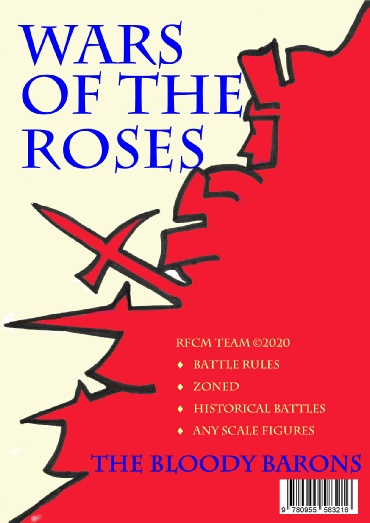|
Wars of the Roses The Bloody Barons |
|
|
This is all about the 2020, 2nd Edition. |
|
|
|
|
|
Free downloads This is an exceptional set of rules, that allow large armies to be engaged with the level of control suitable to a general.
BB allows you to have what those generals had, rather than what the writer thinks you would like to have in order to buy their game. Game usually last about 2.5 hours. A full and proper set of rules; no supplements needed. |
|
|
1. In what ways is it the same as the first edition? The new version uses the same base sizes for figures. |
2. Period of Warfare covered Wars of the Roses. 1455- |
|
3. Game setting The game puts the players in the role of general. This means that trivial matters fitting to a captain are not done by the general. "The general is here lord, to remind us to load our bows. What shall I tell him?" |
4. Associated Peter Pig range |
|
5. Game scenario generator Firstly players carry out a "piggy chase" to determine which player is the attacker. The four aspects of the scenario are applied after the armies are deployed. The scenario results are inflicted upon the armies instantly. No record keeping. |
6. Game table size Wars of the Roses. 1455- Table measures 4 zones by 4 zones. In 15mm this gives a table size of 4 feet width by 3 feet depth. In 25,mm this becomes 6 foot by 4 foot. |
|
7. How much scenery needed Usually 7 pieces. Each piece fills a zone. |
8. How many D6 needed 14. |
|
9. Measurement method No measuring. Wards (groups of units) move from zone to zone. Usually at the rate of 1 zone per turn. The table is made up of 16 zones; in four rows of 4. |
10. Basing convention Any base size is acceptable. This due to the game being zonal rather than fussy. remember the player is a general not a drill sergeant. More "Left flank advance" instead of "3.5 cm movement combined with a 20' wheel" |
|
11. Typical army composition Units, each of 8 increments. These increments could be 4 bases, dying by the half. base, 8 figures dying by the figure or 1 big base with a D6 to record first 6 increments of death (units disperse when down to two increments).. 14 Units in a typical army. |
12. Army composition lists |
|
13. Unit motivation mechanism A ward is composed of 1- |
14. Action/moving mechanism Player says " I am moving this ward to this new zone". Done. |
|
15. Shooting mechanism Units in order get 2D6 per unit. Thus a ward usually rolls 6D6. |
16. Fighting mechanism A ward fights another ward. One big bunch of dice. |
|
17. Morale mechanism Morale taken by any ward with casualty markers. Whole ward affected. Stand, withdraw, rout. |
18. Game length Usually about 4 turns per player. Variable end time. |
|
19. Book keeping Limited to notation of Generals' attributes. |
20. Principal victory condition Ownership of zones, especially centre of defender deployment area. |
|
21. Changes needed for 25mm gaming Just use bigger zones. |
22. Best parts (Bits we like about the game) 1. Unreliable generals letting down everyone. |















